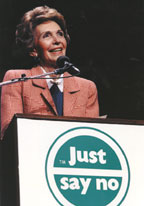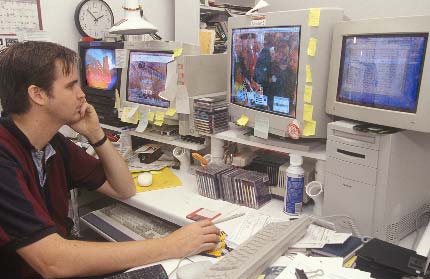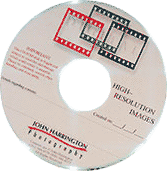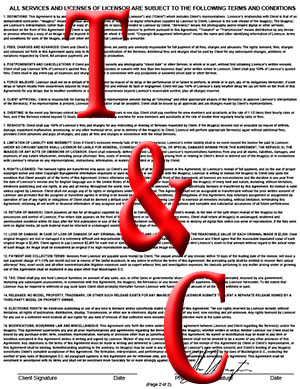Just Say "No", Just So Oversimplified
 Back in the free-wheeling days of the early 80's, drug use was rampant. It was, however, much more intense (and deadly) than that of the 60's, where it was free-love and pot, with the occasional 'shroom and LSD for the heavy. Cocaine, Heroin, Speed, Crank, Meth, and so forth and so on, were the problems that lead Nancy Reagan to launch her "Just Say No" campaign,
Back in the free-wheeling days of the early 80's, drug use was rampant. It was, however, much more intense (and deadly) than that of the 60's, where it was free-love and pot, with the occasional 'shroom and LSD for the heavy. Cocaine, Heroin, Speed, Crank, Meth, and so forth and so on, were the problems that lead Nancy Reagan to launch her "Just Say No" campaign,  and it really was a black and white issue. Even McGruff the Crime Dog was roped into the effort. It wasn't "don't drink and drive", "don't smoke a joint and then use heavy equipment." There was no grey area, no refuge where, if the circumstances were right, drug use was okay. It was clinical fact that using drugs detroyed - forever - brain cells.
and it really was a black and white issue. Even McGruff the Crime Dog was roped into the effort. It wasn't "don't drink and drive", "don't smoke a joint and then use heavy equipment." There was no grey area, no refuge where, if the circumstances were right, drug use was okay. It was clinical fact that using drugs detroyed - forever - brain cells. Graphics design organizations have promoted the "just say 'no' to spec" campaign, because firms were being asked to create works on the speculation that if the prospective client liked it, then - and only then - would the prospective client actually become a client, and pay you for your work. I can recall when Rolling Stone would give actual assignments - paid against space rate - for concert photography in the DC area. Then there was one or two photographers willing to shoot for them on spec, even travelling 90 miles south to Richmond to cover a concert - on spec - just so they could say "I'm here for Rolling Stone." Yet, interestingly enough, even while that was happening, when they were not available, my remaining with the "assignment fee, plus expenses, against space" position meant that I got paid for the assignment regardless of if they published the photos.
Graphics design organizations have promoted the "just say 'no' to spec" campaign, because firms were being asked to create works on the speculation that if the prospective client liked it, then - and only then - would the prospective client actually become a client, and pay you for your work. I can recall when Rolling Stone would give actual assignments - paid against space rate - for concert photography in the DC area. Then there was one or two photographers willing to shoot for them on spec, even travelling 90 miles south to Richmond to cover a concert - on spec - just so they could say "I'm here for Rolling Stone." Yet, interestingly enough, even while that was happening, when they were not available, my remaining with the "assignment fee, plus expenses, against space" position meant that I got paid for the assignment regardless of if they published the photos. The Advertising Photographers of America even jumped into the fray, when ad agencies tried to secure photography for their campaigns on spec. A revolt lead many of the prestigious agencies to stop asking for spec work, yet this still pops it's head up from time to time.
The Advertising Photographers of America even jumped into the fray, when ad agencies tried to secure photography for their campaigns on spec. A revolt lead many of the prestigious agencies to stop asking for spec work, yet this still pops it's head up from time to time.
I shall return to the "no spec" issue in another post. I present it as a contrast to the "just say 'no' to bad deals" mantra that was first espoused by the Editorial Photographers organization. That mantra caused many a fair deal to disappear, not because it was bad, but because it was oversimplified by so many during their implementation of the concept. Consider this exchange:
Editor:Hi John, would you do this assignment for me for $350?THAT is an oversimplification of what happened many a time. Photographers did not return e-mails fishing for low-paying assignments, instead of responding with a reasonable figure, and chalking the estimate-prep as an exercise. Photographers did not engage in a reasoned negotiation with the prospective client, and just walked away.
Me: Hell no.
Editor: Why not?
Me: It's a bad deal. {click}
Editor:John? Hello? John? Heeelllloooo?
When I speak with a client, part of the client dialog includes the question "What budget are you trying to work within?" Oftentimes, they are straight with me. But even when they state a figure that is unreasonably low, my response is not "no", as the oversimplified interpretation of the mantra would call for, but rather, I respond with something like "Let me look this over, and I will send along what I can do for you." And then, in short order, I do. And, guess what? Oftentimes, not only do I get the assignment, but the client notes that I was the only one they talked to that sent an estimate. The others "just said 'no'" and didn't present their position, contract, fees and expenses, and provide a reasonable justification for them. Many a client calls from other parts of the country, where perhaps the market rates for photography might be lower, and they may experience sticker shock when looking to secure a photographer in my area. I am happy to contribute to that sticker shock, because to me, my rates are not a shock, they are fair and reasonable. To date, a majority of my clients - in fact -- all my clients (because if they are my clients, they have hired me at my rates) - find my rates fair.
It made perfect sense for the mantra to apply to drugs, and to a client calling on you with a "spec assignment", but it does a disservice when that interpretation applies to photographers. It's not black and white. At the end of a negotation, where there has been back and forth, and you've proposed your "best and final offer", and the client comes back to you for more cuts/reductions, then it is appropriate to say 'no'. Oftentimes, for me, my first proposal is my best and final offer. Note -- best and final offer (BAFO) is a term that the government uses in contracting, whereby you, the bidder presents your BAFO, and they either accept it, or reject it, period. It is what it says it is, BEST, and FINAL.
My colleague, Stanley Rowin, who also writes a blog on the business side of photography - Pro Photo Business Blog is in the midst of the subject, and I encourage you to read and think about what he's saying. He's written a Part 1, and a Part 2 on the subject, and I expect, his Part 3 conclusion soon. I suspect Stanley will have some good ideas about where to go from here.
Please post your comments by clicking the link below. If you've got questions, please pose them in our Photo Business Forum Flickr Group Discussion Threads.
 Nelson DeMille, one my most favorite fiction authors, wrote one line for one of his characters in his book Plum Island, and it has remained with me for atleast a decade. He wrote (for his character) "The problem with doing nothing is that you never know when you're finished." I have endeavored, as I recall that sentiment, to always be trying to do something.
Nelson DeMille, one my most favorite fiction authors, wrote one line for one of his characters in his book Plum Island, and it has remained with me for atleast a decade. He wrote (for his character) "The problem with doing nothing is that you never know when you're finished." I have endeavored, as I recall that sentiment, to always be trying to do something. The point is, many a friend would be out partying, watching television, and so on. They saw their time off as just time to goof off. I saw that time as the time where I could do whatever it took to chart my course for the future. From the minute my eyes blinked open to the moment I drifted off to sleep, (that's me in the photo, circa 1992 at about 2am editing photos) I was thinking about being a photographer. I was reviewing in my head, line by line, a conversation I had with a prospective client, determining where I'd failed to "close" the deal so I could provide their photography, or cover their assignment. When my eyes closed at night, and I could not fall asleep, I would lay in the darkness, the street lamps glowing dimly through my north-facing window, thinking about how I could improve. Improve my photography. Improve my lighting skills. Improve my negotiation skills. Improve my knowledge about business. I read every book I could -- many many of them listed in my recommended reading list -- Secrets of Closing the Sale, What They Don't Teach You at Harvard Business School -- and so on. I pushed myself. I knew as sure as I could, that if I just worked harder -- and smarter (or as smarter as I could) -- than my "competition", I could achieve (and sustain) my dream career, one as a photographer, where it's work but not a job.
The point is, many a friend would be out partying, watching television, and so on. They saw their time off as just time to goof off. I saw that time as the time where I could do whatever it took to chart my course for the future. From the minute my eyes blinked open to the moment I drifted off to sleep, (that's me in the photo, circa 1992 at about 2am editing photos) I was thinking about being a photographer. I was reviewing in my head, line by line, a conversation I had with a prospective client, determining where I'd failed to "close" the deal so I could provide their photography, or cover their assignment. When my eyes closed at night, and I could not fall asleep, I would lay in the darkness, the street lamps glowing dimly through my north-facing window, thinking about how I could improve. Improve my photography. Improve my lighting skills. Improve my negotiation skills. Improve my knowledge about business. I read every book I could -- many many of them listed in my recommended reading list -- Secrets of Closing the Sale, What They Don't Teach You at Harvard Business School -- and so on. I pushed myself. I knew as sure as I could, that if I just worked harder -- and smarter (or as smarter as I could) -- than my "competition", I could achieve (and sustain) my dream career, one as a photographer, where it's work but not a job. I love what I do. I can't imagine doing anything else. I am so very grateful for whatever station in life I am at, and wherever in life I end up. My time now when I arise is spent dressing my daughters for school, making lunches, and when they come home, and I am not making photographs on an evening assignment, I am saying grace with them, coloring with them,
I love what I do. I can't imagine doing anything else. I am so very grateful for whatever station in life I am at, and wherever in life I end up. My time now when I arise is spent dressing my daughters for school, making lunches, and when they come home, and I am not making photographs on an evening assignment, I am saying grace with them, coloring with them,  and tucking them into bed, (that's them, on Halloween last year) and then I can sit down, and watch a few television shows with my wife, shows we've grown to cherish, and we have them for many of the weekday evening nights, save for Fridays, which are sacrosanct "movie nights", where we get a family-friendly dvd and gather together and have popcorn as a family. The girls all look forward to those nights, and I do too.
and tucking them into bed, (that's them, on Halloween last year) and then I can sit down, and watch a few television shows with my wife, shows we've grown to cherish, and we have them for many of the weekday evening nights, save for Fridays, which are sacrosanct "movie nights", where we get a family-friendly dvd and gather together and have popcorn as a family. The girls all look forward to those nights, and I do too.  Ah, it's a nice sight when the
Ah, it's a nice sight when the  Over in the Flickr forums,
Over in the Flickr forums,  This Term lays out several definitions of words that will be used in the contract. Why is this necessary? Because lawyers love to debate (usually in court, often in settlement agreements) EXACTLY what was meant by a term, who was included (or not included) as a licensee, and such. This helps set forth what things mean.
This Term lays out several definitions of words that will be used in the contract. Why is this necessary? Because lawyers love to debate (usually in court, often in settlement agreements) EXACTLY what was meant by a term, who was included (or not included) as a licensee, and such. This helps set forth what things mean.